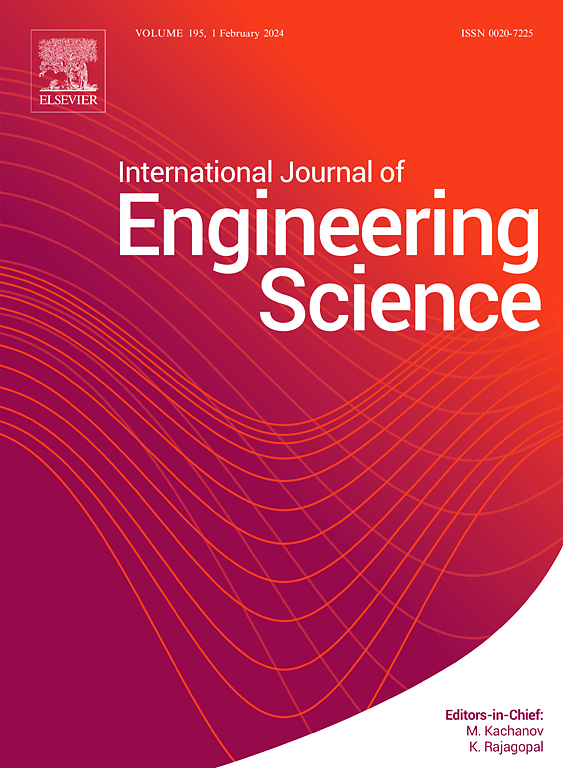利用实验数据优化骨适应模型参数
IF 5.7
1区 工程技术
Q1 ENGINEERING, MULTIDISCIPLINARY
International Journal of Engineering Science
Pub Date : 2025-01-30
DOI:10.1016/j.ijengsci.2024.104209
引用次数: 0
摘要
骨小梁是一种有生命的材料,当受到载荷时,它可以适应其空间组织和机械性能。有人试图用数学模型来描述小梁骨的适应性,以调节吸收和形成活动作为机械刺激的功能。本文提出并研究了一种优化骨适应模型参数的方法,并将骨小梁-骨适应的模拟结果与6个月生理负荷后参与者远端胫骨的高分辨率外周定量计算机断层扫描(HR-pQCT)进行了定量比较。为此,从参与者小梁骨的基线扫描中开发了有限元模型,并将其用作初始域,以运行由Fortran子程序中实现的骨适应模型调节的模拟。模拟结果逐单元与后续HR-pQCT扫描的相应模型进行比较。优化了骨适应模型的力学参数,以提高模拟模型与随访的基于hr - pqct的模型之间的一致性。所开发的方法捕获了骨体积分数、骨小梁厚度和分离变化的主要趋势,并在使用骨适应参数的优化值时,与实验模型实现了84 - 93%的逐单元对应。这些优化值在骨头的横截面上是不同的。在代表生理负荷的边界条件下,他们预测胫骨远端内区骨吸收率高于外区,胫骨前-内区、内侧-内区和内侧-外区骨吸收率增强,胫骨远端外区骨形成率高于内区,胫骨外侧-外区骨形成率增强。本文章由计算机程序翻译,如有差异,请以英文原文为准。

Optimising parameters of bone-adaptation model using experimental data
Trabecular bone is a living material that adapts its spatial organisation and mechanical properties when subjected to loading. There were efforts to describe adaptation in trabecular bone with mathematical models regulating resorption and formation activities as a function of mechanical stimuli. In this paper, an approach to optimise parameters of a bone-adaptation model is proposed and investigated, and the simulation results of trabecular-bone adaptation are quantitatively compared with high-resolution peripheral quantitative computed tomography (HR-pQCT) scans of a distal tibia in a participant following six months of physiological loading. For this purpose, finite-element models were developed from baseline scans of the participant's trabecular bone and used as an initial domain to run simulations regulated by the bone-adaptation model implemented in a Fortran subroutine. The simulated results were element-by-element compared with the corresponding models from follow-up HR-pQCT scans. Mechanostat parameters of the bone-adaptation model were optimised to improve correspondence between the simulated and follow-up HR-pQCT-based models.
The developed approach captured the main trends in changes of bone volume fraction, trabecular thickness and separation and achieved 84 – 93 % of the element-by-element correspondence with the experimental models when utilising the optimised values of bone-adaptation parameters. These optimised values were different across the bone's cross-section. In the boundary conditions representing physiological loading, they predicted higher bone resorption rate in the inner regions of distal tibia than in the outer regions, intensified bone resorption in the anterior-inner, medial-inner and medial-outer regions, higher bone formation rate in the outer regions of distal tibia than in the inner regions, and intensified bone formation in the lateral-outer region.
求助全文
通过发布文献求助,成功后即可免费获取论文全文。
去求助
来源期刊

International Journal of Engineering Science
工程技术-工程:综合
CiteScore
11.80
自引率
16.70%
发文量
86
审稿时长
45 days
期刊介绍:
The International Journal of Engineering Science is not limited to a specific aspect of science and engineering but is instead devoted to a wide range of subfields in the engineering sciences. While it encourages a broad spectrum of contribution in the engineering sciences, its core interest lies in issues concerning material modeling and response. Articles of interdisciplinary nature are particularly welcome.
The primary goal of the new editors is to maintain high quality of publications. There will be a commitment to expediting the time taken for the publication of the papers. The articles that are sent for reviews will have names of the authors deleted with a view towards enhancing the objectivity and fairness of the review process.
Articles that are devoted to the purely mathematical aspects without a discussion of the physical implications of the results or the consideration of specific examples are discouraged. Articles concerning material science should not be limited merely to a description and recording of observations but should contain theoretical or quantitative discussion of the results.
 求助内容:
求助内容: 应助结果提醒方式:
应助结果提醒方式:


